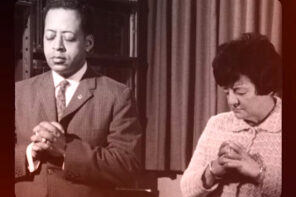If art is the new religion, then museums are the new temples; temples uniquely suited to the vagaries of spirituality in the modern age.
That is the suggestive idea explored in Marcia Brennan’s new book, Curating Consciousness. Brennan introduces us to James Johnson Sweeney (1900-1968), a provocative art critic, curator, and unapologetic modernist who devoted most of his professional life to the promotion of “the museum as a secular temple of art.”
While the spiritual orientation of a great deal of modern Abstraction is widely recognized and widely appreciated, it was Brennan who suggested that there was a curatorial side to these ideas, one that had not been seen or explored. Certainly Kandinsky’s 1911 manifesto, Concerning the Spiritual in Art, announced the deeply religious interests and the spiritual ambition behind one kind of Abstraction, but Sweeney tried to make museums themselves into more self-consciously spiritual spaces.
Art as religion and museums as temples… these ideas make better sense if we are willing to loosen up our understanding of the word ‘religion’ and to broaden our sense of what counts as a “temple.” It is in this sense that the story this book tells fits in nicely with one of the main tasks of this magazine. Sweeney’s aesthetic vision was uniquely attuned to the religiously fluid sensibilities of the fifties and sixties, but the curatorial energies he unleashed have not come to rest in our own time. That is the bold thesis Marcia Brennan seeks to display in this rich and supple history.
Sweeney emerges as one of the truly fascinating figures in mid-century North American art. Born in Brooklyn to an Irish Catholic family, Sweeney graduated from Georgetown University in 1922, then pursued his graduate work at Jesus College, Cambridge, as well as at the Sorbonne and the University of Siena. His deep ties to the European art scene would play a major part in his life’s work. He began working as a curator in the 1930s, first at the University of Chicago (1933-1934), then took a lectureship at the Institute of Fine Arts in New York (1935-1940). He was then appointed as director of the Department of Painting and Sculpture at the Museum of Modern Art at the end of the Second World War (1945-1946).
It was in the aftermath of that apocalyptic period that Sweeney (and others) began to reflect more explicitly on art’s potential role in the work of spiritual renewal. Brennan cites “the thirst for transcendence and totality” (quoting Stephen Wasserstrom, 23) that animated many artists and aestheticians in the aftermath of the War. In 1948, Sweeney was invited to participate in a study group devoted to the spiritual potential of the visual arts that was held under the aegis of the “Conference on Science, Philosophy and Religion.” Prominent religious figures such Paul Tillich and Louis Finkelstein were members of the group. Inspired by the work of this seminar, Sweeney also was appointed to the Board of Directors of the Religious Art Center of America, a nonprofit organization under the direction of the Reverend William Granger Ryan, then president of Seton Hill, a Catholic Liberal Arts college in Pennsylvania.
Clearly, a new spirit of religious pluralism and earnest spiritual seeking was in the air, well before such ideas became popular—first mainstreamed, then trivialized—in the later sixties. Sweeney’s curatorial work was aimed at preventing the crasser kinds of marketing and the trivialization of the New Age.
The historical dimension of this story is important; in some ways the Fifties and Sixties seem impossibly far away, compared to the way religion and spirituality are represented in mainstream America today. Just compare King’s bold speech before the Lincoln Memorial in the early 1960s, to Glenn Beck’s and Sarah Palin’s religious rhetoric in 2010…
There were progressive and aesthetically sophisticated Catholics in the U.S., and James Sweeney identified himself as one. These were the men and women who created the culture in which the Second Vatican Council made sense. Sweeney was profligate in his reading, and daring in the range of spiritual traditions he established as part of his curatorial vision (6, 23). Heraclitus, Neoplatonic mysticism, medieval mystics like Julian of Norwich and Nicolas of Cusa, Emerson and Whitman, William James, Mircea Eliade, Gershom Sholem, Henry Corbin, scholars of Taoism like Arthur Waley, T.S. Eliot, St. John of the Cross… all were part of the eclectic artistic-and-spiritual vision he embraced. Sweeney became ever more interested in symbols, the relation of images to insight. He became interested in play, serious and often ritualized play. And he became positively obsessed with the apophatic tradition of “negative theology,” the idea that all we can meaningfully say about God is what God is not. Such a negative moment—what Plato called an aporia, a “no-way-out” for thinking—casts the aspiring soul back on the creative imagination in order to suggest visually what may not be said clearly with words.
For Sweeney, art was crucial as a tool to help us see seeing as a form of imagining, and thereby unleashing the inner forces of spiritual creativity. His two most influential positions were as Director of the Simon Guggenheim Museum in New York (1952-1960); he was there when the new building designed by Frank Lloyd Wright opened, though he was ambivalent about it, worrying that the space was designed to promote the architect, not a spiritual experience of inner space. And then he served as Director of the Museum of Fine Arts in Houston (1961-1967). The shows Sweeney curated, the work he collected, and the artists whom he knew personally, read like a Who’s Who of the Modern: Pierre Alechinsky, Corneille Beverloo, Constantin Brancusi, Alberto Burri (chapter 4), Alexander Calder, Marc Chagall, Eduardo Chillida (chapter 7), Stuart Davis, Robert Delauney, Marcel Duchamp (chapter 3), Lucio Fontana, Paul Klee, Franz Kline, Joan Mirò, Piet Mondrian, Henry Moore, Robert Motherwell, Georgia O’Keefe, Jackson Pollock, Mark Rothko, Niki de Saint Phalle, Pierre Soulages (chapter 5), Antoni Tapies, Jean Tinguely (chapter 6), Mark Tobey.
Sweeney was a tireless traveler, as well as a tireless writer and promoter of his aesthetic and curatorial ideas. His was a version “of midcentury modernism that placed the numinous at its core.” He believed that the avant garde offered a refuge for modern religious sentiments, what others have called “a secular form of belief.” But perhaps Sweeney’s greatest novelty was his refusal of the secular, his profound awareness that we might just as easily speak of the spiritual in new and heretofore unimagined forms–no reason to call it “secular.” His curatorial interest in promoting consciousness turned “in part on a suggestive paradox: How can modernist aesthetics be reconnected with a complex mystical tradition from which it has never been separated?” (italics mine). In other words, how may the modern museum escape the fiction of its own secularity and thereby rediscover its spiritual roots, its spiritual task?
It is telling that Sweeney’s bold vision was not entirely successful. He resigned from the Guggenheim when Harry Frank Guggenheim encouraged him to promote “a more popular educational approach.” And he was later asked to step down from his post at the Houston Museum when his “innovative if controversial curatorial approach came up against the practical reality of the art museum as a social signifier fully embedded in an haut bourgeois world, one in which Sweeney could form strategic alliances but never a lasting arrangement.”
And yet, even as he was being asked to step down or was pushed out the door, Sweeney was winning awards, celebrated as a visionary, and congratulated for the civic renaissances in each of the cities where he worked. Such accolades perhaps offer us reasons for cautious optimism as we consider the complex pattern of the religious landscape in the United States today.




